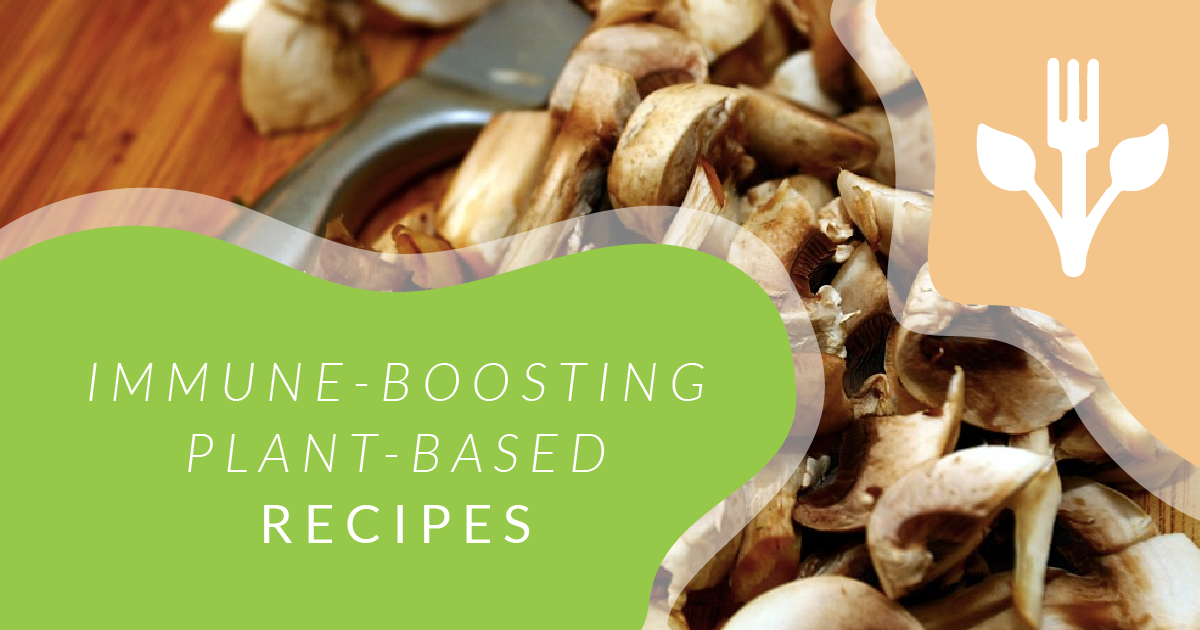We believe in the power of plants to help boost immunity, and feel this is especially important now, as the coronavirus impacts people all over the globe. For our last blog feature, we focused on healthy immunity. Here, we’ve selected plant-based recipes to support overall immune system health.
As always, we recommend following the guidelines from the Center for Disease Control and Prevention such as handwashing and staying at home as much as possible. It’s also important to take stock of what we put inside our bodies in order to stay healthy.
Plant-based Recipes for Healthy Immunity
Arugula and Avocado Salad with Miso-Ginger Dressing
This recipe from the Greens and Grains on the Deep Blue Sea Cookbook yields 4 to 6 servings.
Ingredients for the Salad
- 1½ cups cubed avocado
- 1 cup julienne-cut carrots
- 1 tablespoon lemon juice
- 2½ cups romaine lettuce strips (3/4 inch wide)
- 2 cups baby arugula
- 1 tablespoon toasted sesame seeds
Ingredients for the Miso-Ginger Dressing
- 5½ tablespoons water
- 2½ tablespoons olive oil
- 1½ teaspoons white miso
- 1½ tablespoons finely chopped pickled ginger
Directions
- Combine all of the dressing ingredients in a small bowl, blend with a whisk, and set aside.
- Place the avocado and carrots in a large salad bowl. Sprinkle with lemon juice and mix gently. Add the romaine and arugula.
- Pour the dressing over the salad and toss gently. Garnish with sesame seeds and serve immediately.
Variations
- Use watercress, sunflower sprouts, or radish greens instead of arugula.
- Add thin red onion slices. Instead of pickled ginger, use 1 tablespoon fresh ginger juice and 1½ teaspoons rice syrup.
A Splash of Lemon
Believe it or not, adding just a splash of lemon juice to certain ingredients, like avocados, apples, and bananas, will prevent them from turning brown.
Quinoa Tabbouleh
This recipe by Jessica Porter yields 4 to 6 servings.
Ingredients
- 1 cup quinoa
- 1½ cups spring water
- ¼ to ½ teaspoon salt
- Peppermint tea bag (optional)
- ¼ cup olive oil
- 2 cloves garlic, minced
- ¼ to ⅓ cup lemon juice
- 1 tablespoon fresh mint, chopped fine
- 1 small tomato, diced (optional)
- 1 cup cucumber, diced
- ¼ cup Kalamata olives, halved
- ¼ red onion, sliced finely into half moons
- ¼ cup chopped parsley
Directions
- Rinse quinoa well. Over medium-low heat, dry roast it in a skillet for a few minutes, stirring continually until it gives off a slightly nutty aroma.
- Bring the water, salt, and, if desired, tea bag to a rolling boil in a small pot. Boil for 1 minute and remove the tea bag. Add the quinoa, cover, and reduce heat to low. Let simmer for 20 minutes or until all water is absorbed. Spoon the quinoa into a bowl to cool.
- Combine the oil, garlic, lemon juice and mint into a dressing. When the quinoa is cool, toss in the tomato (if you’re using it), cucumber, olives, onion, parsley and dressing to taste.
- Serve immediately or chill first. Great with pita bread and hummus.
Ultimate Miso Soup
Miso offers a significant number of health benefits, and miso soup is often taken to help restore health and/or prevent disease. When making miso soup for medicinal purposes, we always add vegetables and other foods that have well-documented healing properties. Synergistically, the following ingredients, when combined in miso soup, pack a powerful medicinal punch.
- Shiitake – In addition to its anti-viral properties, the shiitake mushroom is also known for strengthening the immune system, reducing the risk of some cancers, and lowering cholesterol and high blood pressure.
- Onions – The regular consumption of onions is associated with a significantly reduced risk of developing colon cancer. Onions also help lower cholesterol levels and blood pressure, reducing the risk of heart attack and stroke. They have anti-inflammatory and anti-bacterial properties as well.
- Carrots – The richest vegetable source of powerful antioxidant compounds known as carotenoids, carrots protect against cardiovascular disease and cancer, promote good vision, help regulate blood sugar, and enhance the immune system.
- Kale – Rich in phytonutrients that lower the risk of a variety of cancers including breast and ovarian, kale lends support to the immune system. Kale also helps combat anemia and prevent cataracts, heart disease and stroke.
- Tofu – Rich in soy protein, tofu, when eaten regularly, can lower cholesterol as much as 30 percent, lower LDL (“bad” cholesterol”) levels up to 40 percent, lower triglyceride levels, and reduce the formation of blood clots – greatly reducing the risk of heart disease and stroke.
This recipe, which yields 4-5 servings, is from The Miso Book: The Art of Cooking with Miso by John and Jan Belleme. The ingredients in this soup work together to enhance miso’s medicinal benefits.
Ingredients
- 6 cups Shiitake or Kombu-Shiitake Stock (see recipe below)
- 1 medium onion, thinly sliced in half moons
- 4-5 shiitake caps, thinly sliced
- 2-3 medium carrots, thinly sliced on the diagonal
- 1½ cups chopped kale
- 8 ounces fresh tofu, cut into 1/2-inch cubes
- 3 tablespoons red, brown rice or barley miso
Directions
- Combine the stock, onion, and shiitake in a 3-quart pot and bring to a boil. Reduce the heat to low and simmer for 5 minutes.
- Add the carrots and kale and simmer 8 to 10 minutes more, or until the kale is tender.
- Add the tofu and cook for 1 to 2 minutes.
- Dissolve the miso in some of the broth and add to the soup. Remove from heat and steep a minute before serving.
Variations
- You can endlessly vary the vegetables in miso soup according to the season or what you have on hand.
- Add a little peeled and finely grated fresh ginger to taste before serving.
- Garnish with sliced green onions.
Shiitake Stock
This simple and versatile stock works well as the basis of almost any type of soup, stew or sauce. Besides its great taste, shiitake offers powerful healing benefits. It yields about 6 cups.
Ingredients
- 5 dried shiitake mushrooms
- 6 cups water
Directions
- Place the shiitake in a medium-sized bowl and cover with the water. Use a small plate to keep the mushrooms submerged, and soak for at least 2-3 hours, longer if time permits.
- Remove and discard the stems from the soaked shiitake, thinly slice the caps, and return to the stock.
- Transfer the stock to a pot and bring to a boil. Reduce the heat to medium-low and gently simmer for 15 minutes.
- Use the stock immediately, refrigerate in a covered container for up to 5 days, or freeze for up to 6 months.
Variations
- For a Kombu-Shiitake stock, simply add a 4-inch piece of kombu to the shiitake while soaking. Remove the kombu once the stock comes to a boil. You can reserve it for use when cooking beans or making bean soups.
- If you don’t have time to soak the shiitake for 2-3 hours, soak the dried mushrooms for 15-20 minutes, bring to a boil and gently simmer for 15 minutes. If time allows, let the shiitake steep in the hot liquid for 30 minutes or so. Remove the mushrooms and reserve them for another use.





























